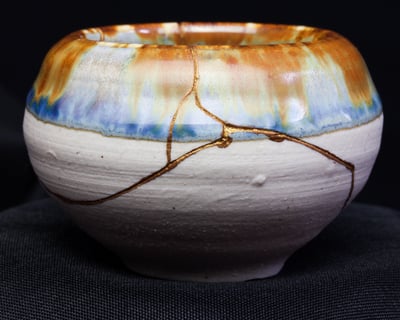 As regular readers of this blog know, many of the ideas and practices that guide the modern continuous improvement movement have their origins in Japanese philosophy and culture. Today’s leaders talk about kaizen (improvement), hoshin kanri (direction setting), and kanban (visual management) regularly. Recently, while scrolling through my Instagram feed of all things, I was struck by another Japanese concept that deserves some thought in the business context as well – the art of Kintsugi.
As regular readers of this blog know, many of the ideas and practices that guide the modern continuous improvement movement have their origins in Japanese philosophy and culture. Today’s leaders talk about kaizen (improvement), hoshin kanri (direction setting), and kanban (visual management) regularly. Recently, while scrolling through my Instagram feed of all things, I was struck by another Japanese concept that deserves some thought in the business context as well – the art of Kintsugi.
Kintsugi which translates to “golden journey” and is also known as Kintsukurio (golden repair) is the art of repairing broken pottery by joining the broken pieces with lacquer mixed with powdered gold, silver, or platinum. No attempt is made to hide the repair; in fact, the technique highlights it. The repair becomes part of the history of the object. The object is not beautiful despite the fact that it was broken, it is more beautiful because it was broken.
History of the Craft
Historians believe that Kintsugi dates back to the late 15th century. Legend has it that the craft was invented with shogun Ashikaya Yoshimasa sent his favorite tea bowl back to China to have a crack repaired. When it arrived back, Yoshimasa was unhappy that it had been fixed with ugly metal staples. Local artisans searched for an alternative, more beautiful method of repair, and Kintsugi was developed.
Kintsugi encompasses several philosophical ideas that are also evident in continuous improvement, including mottainai, which is regret when something is wasted, and mushin, the acceptance of change.
What is Perfect?
One instinct of workers and leaders is to cover-up or quietly repair mistakes in the hope that no one will know that a problem existed. In the hope that all will believe that every process is perfect, that it has always been perfect, and will always stay that way, we apply quick fixes, ignore data, and pretend that all is well. Kaizen, of course, teaches that perfection can only be achieved through a series of incremental improvements and the application of Standard work.
But what if, it isn’t our processes that need to be perfect? What if, it is our response to process flaws and errors that requires a paradigm shift? What if perfection is the ability to take something broken and transform it into something greater?
Appling Kintsugi Thought to Daily Improvement
There are three relevant lessons in Kintsugi that can be applied to business process improvement.
Lesson 1: Don’t try to hide problems
Who among us hasn’t knocked over a lamp or a vase and tried to repair the damage with Super Glue before a parent got home? How’d that work out? The first lesson of Kintsugi is that we must acknowledge the break and accept that nothing stays the same forever. It isn’t helpful to lament a broken process or seek to place blame. Transformation has great value, but it can’t occur unless the need for it is spoken.
Lesson 2: History is of Great Consequence
Aside from the aesthetic beauty of Kintsugi, the technique does something else that I think is important for business; it captures the moment that the object was changed. When you see a piece of pottery restored in this way, you might ask, “What happened?” The story of the damage becomes an integral part of the piece. In business, it is essential that the stories of process change be repeated. We need to share what happened, why changes were made, and how the process was transformed. That’s one of the reasons that we think a platform for capturing operational change is so important.
Lesson 3: Resilience is Exquisite
It isn’t the organization that implements perfect process and maintains them flawlessly forever that will outperform the competition. That organization doesn’t exist. The organizations that will win in the marketplace are those that are able to recover from processes flaws, changing conditions, new customer demand, and all of the other unpredictable things that are beyond our control. The acts of change and repair shouldn’t be considered “bugs” in kaizen; they are features.
When his tea bowl was broken, shogun Yoshimasa was probably not delighted, but acceptance and resilience created something even more precious than before. That’s a useful way to think about kaizen.



Add a Comment